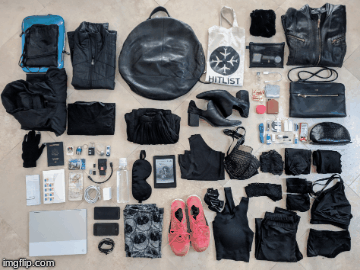For the last four years, I’ve been gradually whittling away at my possessions to the point I carry almost everything I need at all times. I can walk out of the door of wherever I’m living with just my purse and no idea when I’ll be back.
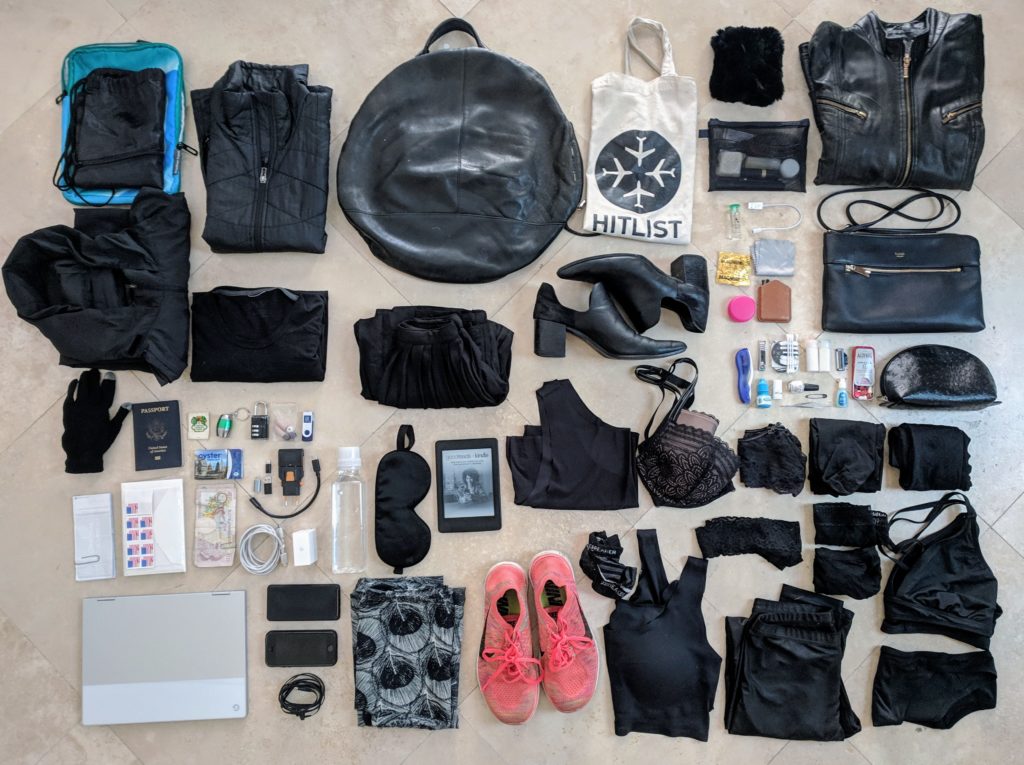
I’m hardly the only digital nomad living out of a backpack. In fact, there’s an entire subreddit dedicated to the art of this particular kind of travel. But I haven’t met many ‘onebag’ers who are also
- Trying to look formal/put together enough for business meetings as opposed to extended leisure/adventure travel
- Women
So here’s my VERY detailed breakdown of everything I need for extended travel – or to keep looking put together every day.
This isn’t just for travelers. Living with less can be good for the environment and good for your mental health. In my case, it’s helped me concentrate on what makes me happy: building a company, spending time with friends and family, and investing in the communities that have helped me live this life.
(Disclosure: I put in some Amazon affiliate links and received some items for free, noted where appropriate).
Apparel, in roughly descending order of how often I wear it:
- Uniqlo airism seamless top ($14.90) – I wear this pretty much every day as a base layer. I used to swear by an Everlane silk cami but last year I switched to a Uniqlo synthetic which is slightly more durable in workouts.
- skirt – I like to bike, so I go with a pleated skirt for mobility. Make sure it has pockets! The one I’m currently wearing I picked up from a Zara in Beirut in 2010 for about $20.
- boots – for dressy occasions, poor weather, or anytime I want to look more put together. I like ones with a bit of a heel but still comfortable enough to wear all day. If I know I’m traveling to only warm weather destinations, I’ll swap these out for a pair of sandals I can dress up / down. My current pair are Charles Davids I bought at Community Thrift in San Francisco for $6.50.
- Ex Officio underwear (x2, $18 each) is the traveler’s staple because they’re easy to wash and quick to dry. I usually carry 2+ extra pairs of various brands because I don’t love the cut of Ex Officio and I don’t want to have to do laundry every other day.
- bra – one regular bra is enough. Currently into the Chantelle Merci plunge bra ($60).
- tights (x2, £8) – extra warmth for little space. I bought these from Marks & Spencer four years ago and have never had to replace them despite wearing probably 50x each, so it seems insane to buy any other brand.

ROAVs on the Great Pyramid 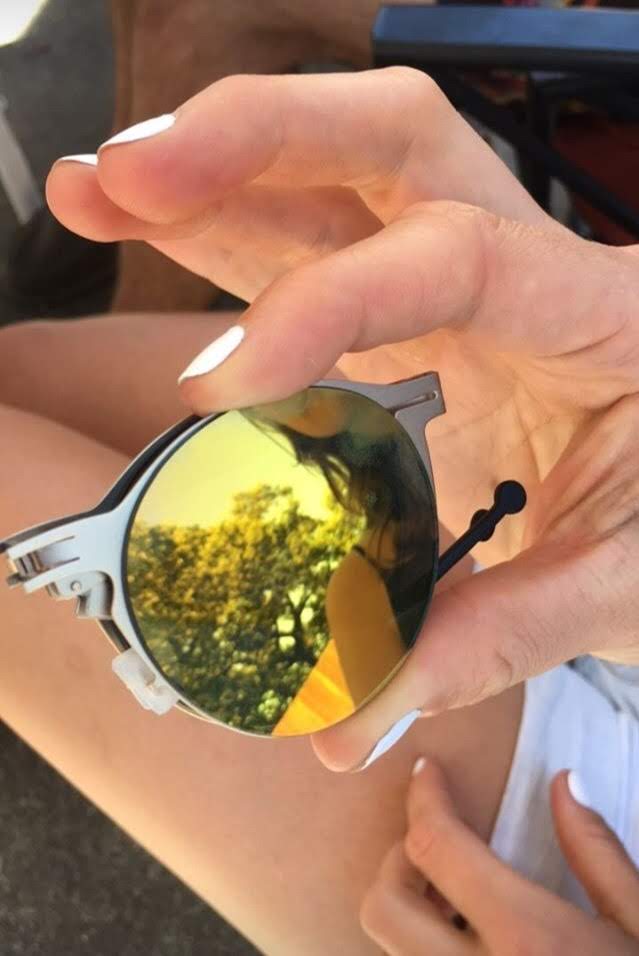
ROAVs folded up
- ROAV folding sunglasses ($165, though the company sent me a pair for free) – anyone who’s hung out with me outside in the last 3 years has probably experienced me unveiling my ROAV sunglasses and trying to convince them to buy their own pair. They weigh almost nothing, collapse to the size of 3 credit cards, protect your eyes effectively with polarized lenses, and look stylish to boot. They’re also incredibly durable: they’ve survived a volleyball to the face (without damaging my face) and two Burning Mans. These are my favorite thing I own.
- leggings – for workouts and colder days (layered over tights if need be). I’m currently wearing a pair from American Apparel I found at Community Thrift ($3) that have a nice sheen to them, sort of like faux leather, but they’re pretty flimsy and I’m excited to try out the Ever Brand Sweatflow leggings ($60), which have pockets (yay) and promise to go five days of continuous wear before they need to be washed (I’m skeptical but have ordered a pair to try them out).
- Uniqlo sports bra ($19.90) – is super lightweight so is comfortable to wear for long plane rides. If I’m doing something that will have me bouncing around a lot I double up with my bikini top.
- bikini – I LOVE Athleta’s sadly discontinued cross strap bikini top (bought on eBay for $40) because I can go for a run or dive off a cliff without worrying about things popping out, while still feeling cute and minimizing tan lines. If I’m doing a light impact workout like yoga I’ll wear this instead of my sports bra. The bikini bottoms can be used as an extra pair of underwear in a pinch. J Crew makes really durable and flatteringly-cut bikini bottoms so I usually just buy a new one when they go on sale.
- Nike free flyknit 4.0 sneakers (bought on eBay for $60) – I used to wear Cole Haan Misha suede oxfords ($100) which I preferred for their street-to-boardroom versatility. I figured it was fine to work out in them because Olympians before the 1980s pretty much wore rubber slippers to run marathons, so how bad could it be to run in unsupportive leather shoes? Then I sprained my ankle for the sixth time (first wearing the Cole Haans) and my doctor politely insisted I wear more supportive shoes. Definitely on the hunt for something with more street style that will keep my ankles from rolling over, but the flyknits are good for workouts for now.
- scarf/coverup – ideally big enough to wear as a dress, use as a blanket, sarong/towel on the beach – 4×6 ft works well for me. A silk/linen/wool blend is excellent for transcending multiple use cases. I bought a swatch of poly blend fabric I liked on 9th St in LA’s fashion district ($13) but wish I’d sprung for silk/wool.
- wool socks – I’ve worn the same pair of icebreaker merino wool socks ($16) for a week straight and I’m not ashamed of it. No smells, no athlete’s foot. I’ve heard people say Darn Tough is even better so I’ll likely switch to that brand when this pair wears out. I usually get by with just one pair of ankle length socks but will bring an extra pair of longer ones if I’ll be in cold weather for extended periods.
- merino wool long sleeve – if you hang it up overnight will smell fresh as a daisy in the morning. I’m currently wearing the Patagonia Capilene midweight (found at Goodwill on 23rd St in Manhattan for $2) but I’d like to replace it with something a bit more ‘office casual’ with the same performance characteristics if I can find it.
- custom made leather jacket from Bilgili Leather in the Grand Bazaar, Istanbul ($165) – this thing is beaten to a mostly pulp after eight years of heavy wear, but it adapts to many styles, doesn’t pick up smells, and has lots of handy pockets. I’d like to replace it with something a bit lighter and a bit more formal looking.
- Uniqlo lightweight packable hooded jacket ($5.90)- for rain, but also as a good extra layer when it’s really cold.
- Columbia Heavenly synthetic down vest ($19 from Headwall Sports in Jackson, WY, amazing source for second hand outdoor gear)

- fur headband ($8.99) – faux if you feel strongly, but nothing matches warmth/weight/style like fur.
- gloves – I have a super cheap knit pair for now but am on the hunt for something more high quality and durable. Have heard good things about the Icebreaker merino glove liners ($25) worn as a standalone for not toooo freezing temperatures.
Toiletries/accessories

I decant most toiletries into MUJI 12ml PE Cylinder with snap top containers, and paint the container tops with nail polish to be able to tell them apart. I also split toiletries into two categories: my overnight bag and a smaller mesh pouch I carry with me all the time. There are a few ‘swing’ items that will make it into my day kit based on weather/time of month.
- overnight bag ($3): a PVC pouch I got on amazon that’s tooled to look like ostrich leather, so I can use it as an extra small clutch for going out.
- tooth powder – a vial the size of a regular tube of travel size toothpaste will last you months (though may raise eyebrows as it looks like about $2k worth of cocaine). I’ve been using Eco-dent ($6.25) but recently sampled Lush’s ‘Tooth Fairy’ ($9.95) and will switch to that when this one runs out because it tastes much better.
- Lush ‘No Doubt’ dry shampoo/body powder – ($8.95) for keeping hair fresh but also for sprinkling inside clothes if you are forced to go longer than expected between showers or washing clothes.
- razor head (no handle) – I briefly traveled with a straight razor because I like that it entails less plastic waste but TSA does not like those razor blades. Now I travel with one or two disposable razor heads.
- q tips, band aids, sanitizing wipes, sewing kit, safety pins, all held in the plastic baggie the MUJI rubber bands ($2.30) came in
- tweezers, nail clippers, eye drops
- Doctor Plotka’s mouthwatcher folding toothbrush ($8.49 for a set of 2)
- OPI mini nail lacquer ($15.95 for a set of 4)
- Public Goods mini lip balm ($1.25)
- Drugs – I store these in a mini Altoid container
- antibiotic – if you might be traveling in places where food poisoning is likely, it’s standard to ask your doctor for a antibiotic prescription. I’ve got cipro, which is a broad spectrum antibiotic; reports vary about whether it’s safe and it’s best to consult a doctor about what makes the most sense for you. I try not to take antibiotics but if something isn’t getting better with a day or two of rest a course of these usually cures what ails me.
- ibuprofen or any standard painkiller
- sweet breath ultra concentrated breath mints – these really belong in my everyday kit but the bottles are so tiny I tend to just keep a few of them in various pockets.
- (optional, not pictured) castile soap – can be used as shampoo, body wash, and laundry detergent. This usually isn’t necessary because I’m either staying at a hotel that provides shampoo/conditioner/body wash; or more likely staying with friends who will have this anyway. If for some reason I am somewhere that doesn’t provide this, I can pick up something at any local drug store.
Essentials that can be slipped into the clutch or my regular bag:

- argan oil ($22 for 2) – all purpose moisturizer for face, body, and hair. Trader Joe’s has a good one that I decant into one of the MUJI tubes.
- reef-friendly sunscreen ($14.44) – I use sunscreen sparingly, because I believe the risk of melanoma is lower than the risk inherent in spreading a bunch of chemicals on my body every day, but will use this on my face if I know I’ll be getting a lot of exposure.
- Lipstick (can also be used as blush), mascara, eye liner – I have had the same mascara and eye liner for 15 years which should indicate how often I use them, and how useless my advice on brands would be.
- Lush Aromaco deodorant ($6.95)- all natural, free of aluminum, lasts for months, and actually works, which is more than you can say of most natural deodorants.
- Mason Pearson pocket hair brush ($105, received as a gift) – I’ve had the same Mason Pearson pocket brush for 20 (!) years and while I wish it were a little smaller, there’s nothing that treats my hair so well.
‘Swing’ items I’ll include depending on plans/time of month:
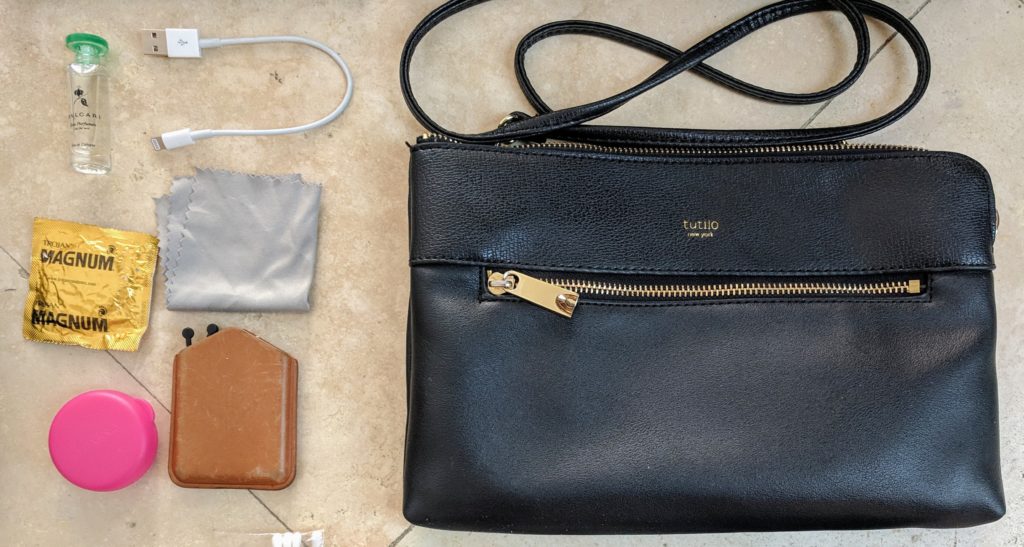
- Intimina collapsible menstrual cup ($28.54) – if you haven’t already gotten on the menstrual cup train, ladies, this is the way to go.
- Condoms – not pictured but Lelo Hex ($19.90/12) earn rave reviews from my male friends.
- ROAV sunglasses (already mentioned in apparel)
- lens cleaning cloth
- small perfume sampler
- USB-3 to lightning adapter
- crossbody clutch/fanny pack – big enough to throw kindle, keys, phone, and an extra layer for if it gets chilly, useful for days when you don’t want to carry around the whole bag. I found this one from a street vendor in NYC for $20.
Electronics
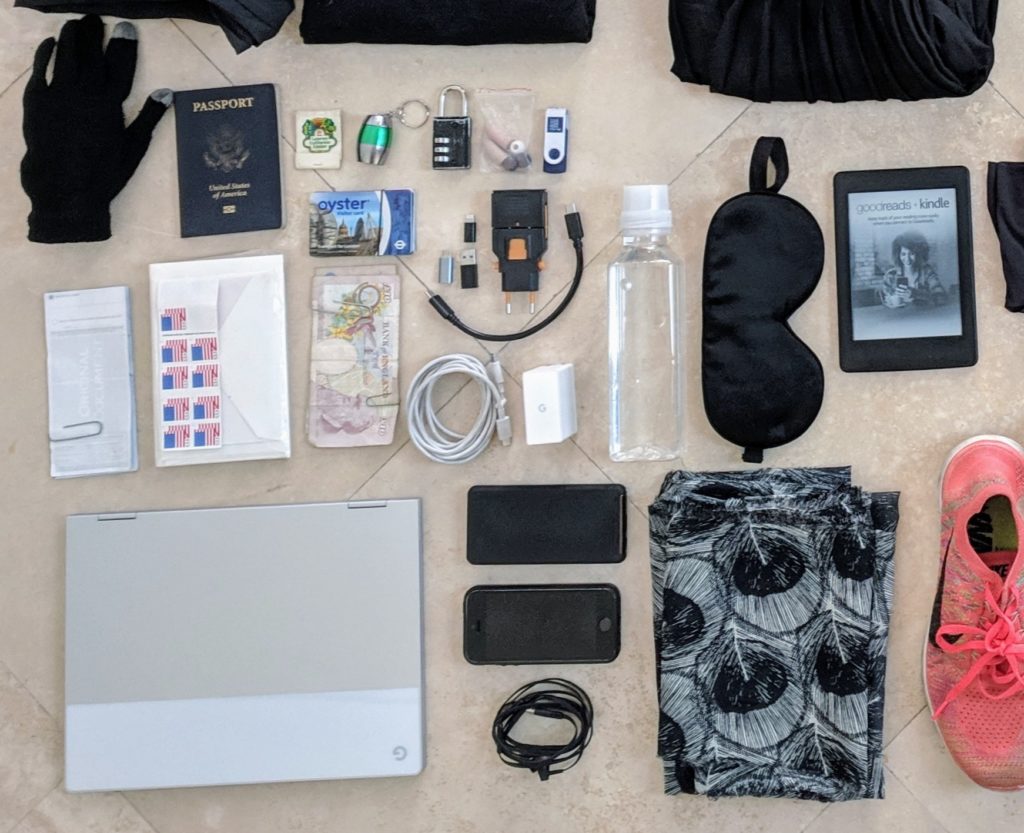
- Pixelbook ($849.95) – replaced my Macbook and I haven’t looked back. Portability, the ability to switch it into a tablet, two USB-C outlets, and affordability for the specs.
- iPhone SE ($399) and Google Pixel (refurb on eBay for $249) – as an app developer I need to have both an iPhone and Android for testing. It’s also useful to have a backup in case one gets stolen, dropped in a toilet, or runs out of battery – just move the SIM card over.
- kindle ($129.99) – I use Libby to check books out from the library.
- headphones ($18.99) – I prefer wired earbuds to wireless because 1. I don’t want another thing to charge and 2. I would probably lose one if they weren’t wired together and 3. I like to be able to plug into in-seat entertainment on airlines and 4. they work as semi effective earplugs if I want to block out noise.
- light ($15.99) – a small flashlight comes in handy more often than you might imagine. I clip this to the outside of my purse.
- Kikkerland universal power adapter ($9.70) is about a third of the size of every other adapter I’ve seen and does everything you need it to.
- USB stick – feels a bit ancient but it comes in handy more often than you’d imagine.
- port adapters – carry fewer cords when you have adapters to make all of them do what you need. I have a long and short usb-c to usb-c cord, then adapters to make those plug into traditional usb, micro usb, and lightning.
Miscellaneous
- lock ($14.99) – for trips to the gym, locking things at the beach, etc.
- stationary + stamps – I like sending thank you notes if I stay at a friend’s house or go to dinner. I also try and send a postcard every day since I find they tend to spark joy.
- Space pen ($16.99)- takes up little space and writes upside down, underwater, and in zero gravity, in case that’s ever relevant.
- checks – it is INCREDIBLE that the US banking system is so backward, but I find checks are sometimes still the cheapest way to move money.
- currency – I try not to carry much cash since you can do pretty much everything by card, but if I have leftover currency at the end of an international trip I keep it in case I end up back in that country in the future, or if I meet a friend that’s heading that direction.
- passport – I carry this with me at all times – you never know when an opportunity for adventure will arise, and it’s also useful to have a backup ID on hand.
- credit cards – I do most of my spending on a Chase Sapphire Preferred card which has excellent travel rewards, no foreign transaction fees, and a reasonable annual fee ($95). The best card for you is highly subjective, I suggest checking out Nerdwallet to help you evaluate the best fit based on your own spending habits.
- debit cards, transit cards, AAA card, health insurance card – since I pass through London, Los Angeles, DC, New York, San Francisco, and Boston with some frequency, I have public transit cards for all of them
- driver’s license
- earplugs, extra earbud pads
- water bottle
- matches
- Alaska bear silk eyeshade ($7.99)
- Hitlist tote bag (priceless) – for picking up groceries or using as overflow if I don’t have time to pack methodically.
- Travel compression packing cube ($16.99) – all my clothes fit in the smallest one.
- Drawstring sack ($9.88) – to separate dirty laundry, take to the gym/beach.
- Cote & Ciel Moselle backpack ($485, received as a gift) – the one bag that fits ALL of the above. I’ve worn this for 7 years and get a lot of compliments, though my ex also referred to it as my ‘deflated couch cushion’, so there’s no accounting for taste. This isn’t the most ergonomic but looks like a fashionable purse and meets every carry on bag restriction.
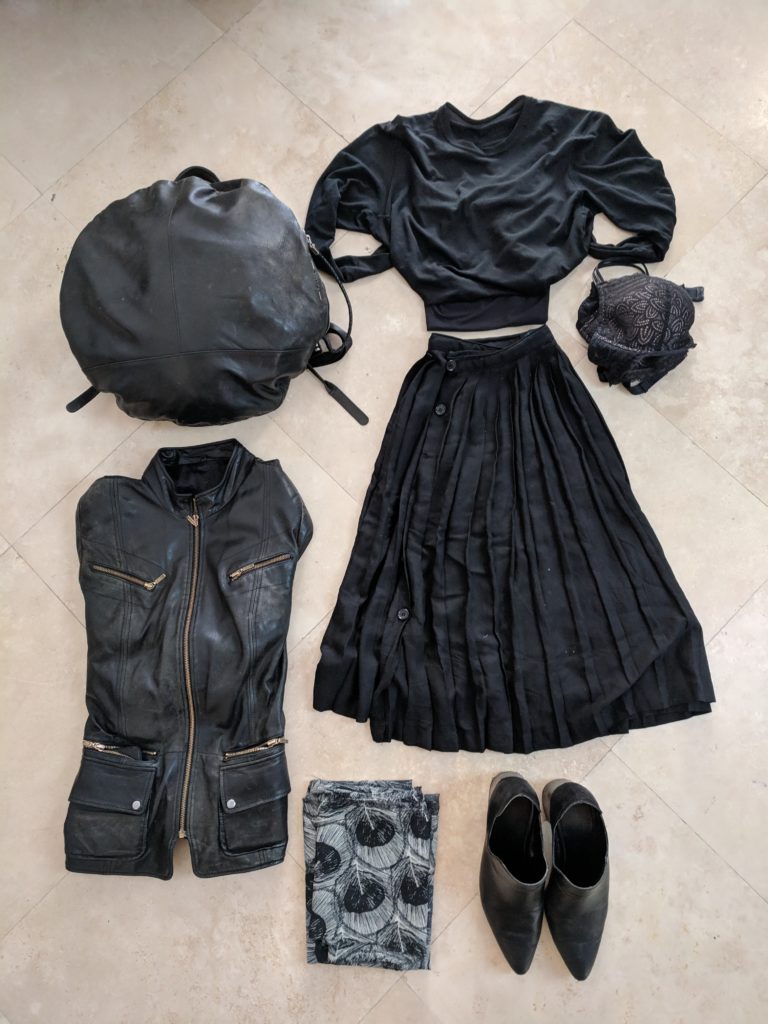
A few last notes for those who are working on getting to the ‘one bag’ lifestyle:
- I have a duffel bag with more winter clothes; hiking boots; ski, biking, and boxing gear; camping essentials; a ballgown; and essential documents (birth certificate, company incorporation docs, etc) that lives wherever I am currently spending the most time. I generally ship it to wherever I’m going to need it rather than carrying on the plane.
- My parents will fairly point out that I still have a closet full of clothes at their house. To be fair on my side, I know my mom raids it and she would never let me throw out my prom dress or marching band T-shirt anyway.
- I try to get clothes I can wear for a long time between washes, and don’t think that should be considered gross. Washing clothes takes a tremendous amount of energy, releases microplastics into the water supply, and destroys the clothes themselves. Wool, silk, leather, and linen last forever and don’t pick up smells. Darker clothes and patterns are less likely to pick up stains. I wash my underwear after every wear and the leggings after 1-2 wears, but very seldom wash the rest of the things in my bag.
- If you ever find yourself lacking something you really need, thrift stores are a great source.
